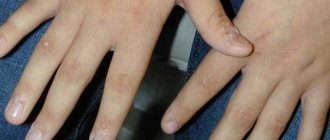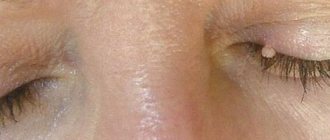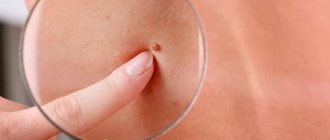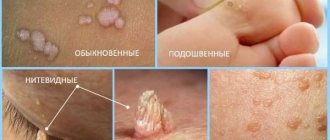A wart is a benign neoplasm localized on the epidermis or mucous membranes. What does a wart look like? In the shape of a pointed cone, round or flat, with a bumpy, uneven surface. The cause of the growths is HPV. Under the influence of papillomavirus, skin cells change their DNA structure and begin to grow rapidly.
Virus replication will depend on the resistance of the immune system. At the first stage, the course of the clinical picture is sluggish. The growth may be almost invisible. Does not cause much concern to the wearer. Perhaps the wart will not grow further and will remain the same size. The immune system will destroy the strain and there will be no problems.
Referring to statistics in virology, most of the world's population are carriers of papillomavirus. When a certain number of factors coincide or the immune system is weak, the infection manifests itself through intensive growth, modifying the surface of the skin not for the better. Along with an unpleasant aesthetic perception, growths can degenerate into oncology.
Signs of viral warts
Various formations often appear on human skin, causing discomfort, but not all of them are warts. Therefore, it is important to know how to identify a viral wart.
The symptoms of this disease are very few. New growths on the skin grow slowly and imperceptibly. They don't itch or hurt. Patients consult a doctor only with complaints about the external unattractiveness of the area of the body affected by warts.
On human feet, warts manifest themselves differently. Under the influence of body weight, they are constantly under pressure and cut into tissues, causing discomfort and pain.
Diagnosis of viral warts is extremely important, because the disease not only brings aesthetic discomfort, but also signals a malfunction of the immune system.
Structure of growths
What is a wart? It is a growth on the skin consisting of overgrown skin cells. When examined under a microscope, the structure of the wart is clearly visible - its roots go deep under the epidermis. The part that protrudes above the skin resembles a small lump or hemispherical lump. Their surface can be hard, elastic, smooth or keratinized. Its structure depends on the location of the growth and its type. The growths can be light, pale yellow, white, and after a long period of time, gray-black.
The visible part of the tumor is a small part of its body, which goes deep under the skin. It feeds through blood vessels that completely penetrate the wart. In addition to the vessels, the body of the growth consists of small pale or red rods in “live” cases and black in healed cases. These rods are the root. If it is done incorrectly, you can see black roots that will stick out from the remaining wound. The smaller the growth, the smaller they are. It is not recommended to get rid of the remaining roots yourself; this is best done by a qualified doctor. If they are not completely eliminated, a relapse may occur over time.
If you examine warts under a microscope in section, you can clearly see the following layers:
- growth body;
- superficial layers of the epidermis;
- deep layers of the epidermis;
- wart root;
- subcutaneous fat layer.
Classification of viral warts
To determine the type of tumor, you need to know what viral warts look like and where they appear. Doctors distinguish the following types:
- ordinary. They are small bumps on the skin of the hands and do not differ in color;
- plantar. Occurs on the feet or toes. They are under pressure, so they grow inward rather than outward. This structure of the wart leads to damage to internal tissues and is accompanied by constant pain. This species is sometimes called "spurs" or "spikes";
- flat. They have a light yellow tint or do not differ at all from the color of the skin. They generally occur more often in children than in adults. Can be found on the bends of the arms, legs, neck, armpits, chest;
- genital warts. Occurs on the genitals. Transmitted sexually, but manifests itself after a few months;
- papillamatous. Occurs in small children under 1 year of age. The wart affects the larynx and gradually grows. If the tumor is not removed in time, it can lead to blockage of the airways.
Pathohistology
Rice.
6. Simple wart. Microscopic picture: excessive keratinization of the outer parts of the epidermis (yellow), proliferation of the basal parts of the epidermis in the form of papillae (green). Van Gieson staining. Pathohistology - thickening of the layers of the epidermis, hyperkeratosis, severe acanthosis, accompanied by a strong development of the papillary layer of the dermis (color. Fig. 6). Infected cells contain inclusions containing large amounts of deoxyribonucleic acid. In the epithelial layer of some warts. They found raspberry and rose hip thorns and asbestos crystals (“asbestos warts”), which may have been the source of a viral infection.
Why do warts appear?
In order to successfully treat and subsequently prevent the recurrence of the disease, it is necessary to understand why it occurred. The cause of viral warts is the human papillomavirus.
Many strains of the virus are completely harmless and do not manifest themselves in any way. Warts occur when the immune system is weakened due to poor diet, an infectious disease, or another virus.
You can become infected with the human papillomavirus through:
- blood. Through direct contact with damaged skin, the virus can be transmitted from wound to wound;
- mucous membranes;
- sexual contact.
Often this disease can be picked up in public places. To avoid infection, you should use only your own hygiene products, towels, and clothing.
The appearance of viral warts in children is associated with their active activity, leading to multiple skin lesions. And in conditions of contact with the virus located in ponds, sandboxes and other places, the disease is guaranteed.
How to defeat viral warts?
Today, many ways to combat warts have been invented. However, it is almost impossible to defeat the virus. If it enters the body, it will remain there forever, but the virus may not manifest itself.
There is no universal method for removing viral warts. Each individual case requires its own method. Therefore, if neoplasms are detected, you should consult a doctor.
Removing warts with treatment
You can get rid of unnecessary tumors using the following medications:
- ointments. Penetrate into the bloodstream through the skin and dull the effect of the virus, which in turn removes warts as a symptom;
- creams. The active substance cauterizes the damaged area from the outside, promoting the death of wart cells;
- tablets. Antiviral and immunostrengthening drugs are used to weaken the disease and improve the body's resistance.
What contributes to the development of the disease
The pathogen enters the human body through skin lesions - cracks, abrasions, scratches. If the immune system works well, then antibodies are formed against the virus, neutralizing it, and it is eliminated from the body after six months to a year. Accordingly, no formations are formed on the skin. If the immune defense (general or skin) is impaired, the virus begins to actively reproduce and change the skin epithelium - warts of one type or another are formed.
Various diseases and certain factors can weaken the immune system:
- past infections;
- physical and emotional overload;
- stressful situations;
- chronic hypothermia;
- endocrine pathologies (diabetes, obesity);
- vitamin deficiency;
- hormonal changes - menopause, pregnancy.
Susceptibility to the virus is determined by the individual characteristics of the body. Due to the weakness of skin immunity, children and the elderly are more susceptible to human papillomavirus infection. In addition to these age categories, those at risk include lovers of swimming pools, baths, saunas, gyms, people suffering from excessive sweating, as well as workers who cut meat carcasses and workers in poultry factories.
Ways to remove warts
So that the tumor does not disturb it, it can be removed. There are several such methods:
- cryodestruction. The method is based on freezing the wart body with liquid nitrogen. After the procedure, tissue necrosis occurs, and it falls off on its own;
- electrocoagulation. Under the influence of current, the wart is detached from the body. The advantages of the method are that it allows you to remove tumors of any size;
- laser removal. Using a laser, the wart is removed painlessly and quickly. The method is gaining more and more popularity.
Contact your doctor if:
- the wart is located in the genital area;
- the tumor itches or bleeds;
- the wart has an uneven color;
- it very quickly changes color, shape, or all together;
- it hurts or is constantly injured (this increases the risk of its degeneration into something very serious);
- their number begins to increase;
- the boundaries of the tumor are blurred or you are not sure that it is a wart. The answer can only be given by an examination by a specialist.
Removing warts using traditional medicine
Methods associated with traditional medicine are quite effective, but it is advisable to first consult with a specialist. To remove warts use: celandine, garlic, vinegar, iodine, etc.











